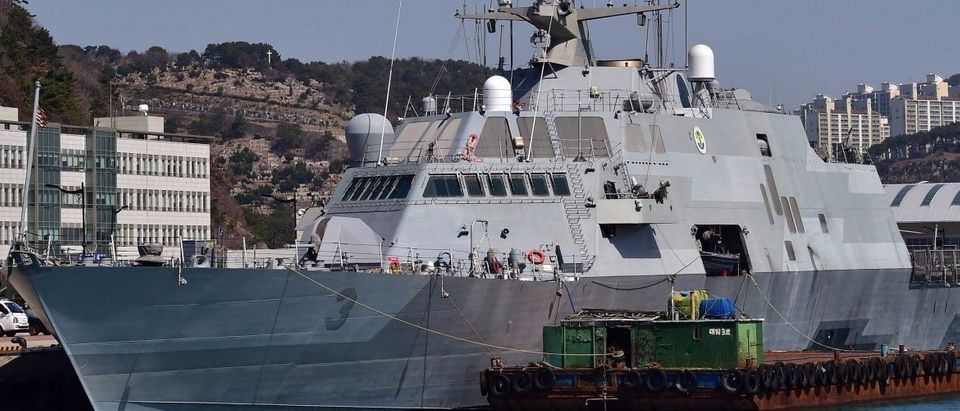The Littoral Combat Ship (or LCS) has drawn a lot of fire recently, notably over its lack of heavier armament. Currently, the LCS is equipped with a 57mm Mk110 gun, two 30mm Bushmaster chain guns, a number of M2 .50-caliber machine guns, and small missiles like the Griffin or Hellfire. All of this is on a ship that displaces 3,500 tons.
So, can this ship be improved? The answer is yes, and it would be surprisingly easy. There are a half-dozen off-the-shelf systems that could give this ship a bigger punch – which could be very necessary given the way the world is going.
System One: The RGM-84 Harpoon
The Harpoon has been the Navy’s standard anti-ship missile for almost four decades. Depending on the variant, it has a maximum range of 60 to 130 nautical miles, and delivers a 500-pound high-explosive warhead.
On surface ships, the missile used the Mk 141 quad launcher. Can it fit on the LCS? Well, it fit on a much smaller warship – the Pegasus-class hydrofoil missile boats (PHMs). The Pegasus and her sisters displaced only 241 tons, and each carried eight Harpoons – enough to ruin an opposing surface-action group’s day.
The latest versions of the Harpoon, the RGM-84L and RGM-84M, can not only put the hurt on surface ships, but also use GPS guidance to hit land targets. Compared to the Hellfire and Griffin missiles currently slated for use on the LCS, the Harpoon is a big step up – and the Navy is already buying it.
System Two: The Mk 75 76mm gun
The Mk 75 76mm gun was the main armament on the Oliver Hazard Perry-class frigates. The Navy went with the Mk 110 largely for the smart ammunition that this 57mm gun uses. However, the Mk 110 has a maximum range of only 9.1 nautical miles. This can be a problem when facing enemy vessels.
While the Mk 75 has a comparable range with conventional shells, OTO Melara has developed a 76mm version of its Vulcano round. The infrared-guided round has a range of 21 nautical miles. OTO Melara also has a round called DART that provided a guided air-to-air capability for the Mk 75. When one considers that the RIM-116 Rolling Airframe Missile has a range of just under five nautical miles, it might not hurt to add the DART and get increased range (8.65 nautical miles), but to also add another weapon that can take down an incoming missile.
System Three: The Mk 15 Phalanx CIWS
While we have looked at providing a bigger punch at longer ranges, there is also the matter of improving the LCS’s survivability against threats. A missile hit can ruin this ship’s day – so it’s probably a smart idea to add another system to prevent the hit from happening in the first place.
The Mk 15 Phalanx is a highly reliable system that uses a 20mm Gatling gun to shoot down incoming missiles. It’s a last-ditch system that can complement the RIM-116 Rolling Airframe Missiles already on the LCS. The Phalanx is also usable against surface targets – making it a very useful addition to the LCS for littoral work, when even a Hellfire missile might be overkill.
System Four: The AGM-119 Penguin anti-ship missile
This Norwegian import was purchased to give the Navy’s helicopters an anti-ship punch. The Penguin features infra-red guidance, a 265-pound warhead, and a range of 15 nautical miles. The Navy’s SH-60B helicopter could carry two of these missiles – and that gave its frigates and destroyers an extra edge in a fight against a surface target.
Not that the Hellfire is a bad missile, but with a range of only 5 nautical miles and a twenty-pound warhead, it will take a lot of Hellfires to equal the damage that one Penguin can do to an enemy ship. And not all the threats the LCS will face will be small boats.
System Five: Mk 32 324mm torpedo tubes
Let’s face it, the LCS may also be asked to deal with submarines as well. While the MH-60R is a very good helicopter, sometimes the bad guys could get close. So, it makes sense to add the Mk 32 torpedo tubes used by the Navy’s other surface combatants to give the LCS an option to deal with that submarine that gets in close. These can fire the Mk 46, Mk 50, or Mk 54 anti-submarine torpedoes, and it would not be a bad idea to have those around.
System Six: The AN/SLQ-25 Nixie
Of course, there is always the likelihood that the other submarine will get a shot off. While the LCS is fast (a top speed of over 45 nautical miles per hour, or knots), some torpedoes can go as high as 70 knots. So, it would not hurt to have a way to make an incoming torpedo miss. The Nixie is a towed decoy that mimics the sounds of a warship, attracting a torpedo that would otherwise cause serious damage – or even sink – the ship towing it. The British learned at the Battle of Jutland that speed was not sufficient to protect a ship – and learning from their mistakes would be a good idea a century later.
The Littoral Combat Ships currently in service have definitely had their hiccups, but some have also flashed some brilliance (like the Freedom’s 2010 SOUTHCOM deployment). A few off-the shelf additions could make the Littoral Combat Ships much better for the Navy in the long run – and that is before the Small Surface Combatant versions enter service.


